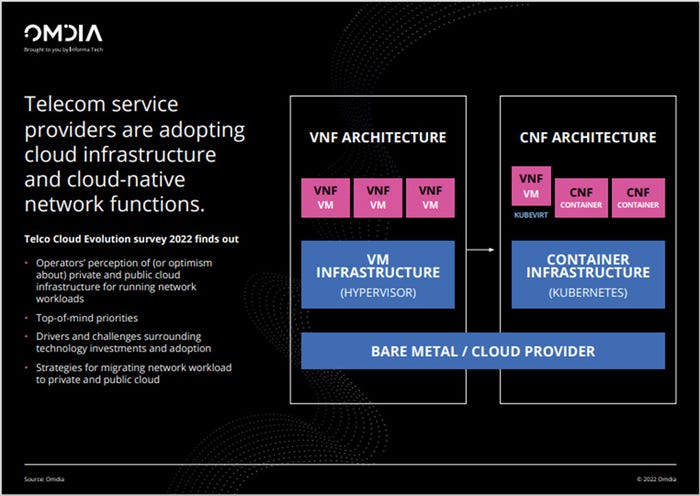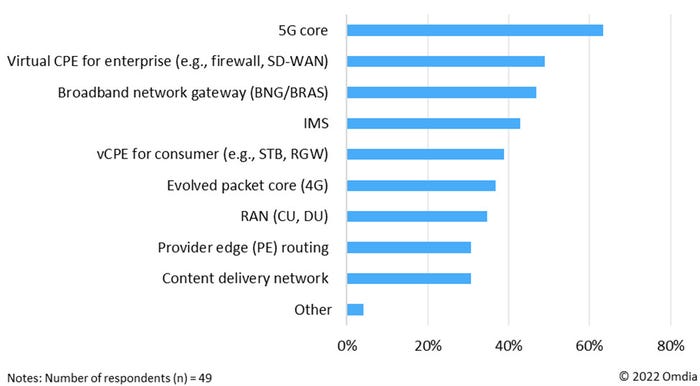Overcoming the challenges telcos face on their journey to containerized network functionsOvercoming the challenges telcos face on their journey to containerized network functions
The benefits of cloud-native are driving telcos to implement network functions as containerized workloads.
December 8, 2022

Telecoms.com periodically invites expert third parties to share their views on the industry’s most pressing issues. In this piece Omdia Analyst Inderpreet Kaur looks at current trends in the evolution of network functions.
Telco cloud has come a long way from its early implementations of network functions virtualization (NFV) to today’s more robust platforms for managing virtualized and cloud-native network functions that are tailored to the needs of telecom network workloads. This shift is bringing many new participants to the rapidly evolving telco cloud landscape. In the recent Telco Cloud Evolution Survey 2022, Omdia found that both public and private cloud technology specialists are shaping this evolution. But before presenting some highlights from the survey, lets understand what this evolution from VNFs to CNFs really means.
Transitioning from VNFs to CNFs
The existing implementations of telco cloud mostly take the virtualization technologies used in datacenter environments and apply them to telco networks. Because telcos always demand “telco-grade” network infrastructure, this virtualization of network functions is supported through a standard reference architecture for management and network orchestration (MANO) defined by the standard development organization, ETSI. The traditional framework by ETSI is defined for virtual machines (VMs) and network functions are packaged as software equivalents to run as instances of VMs. Therefore, a network function can be visualized as a vertically integrated stack consisting of proprietary virtualization infrastructure management (often based on OpenStack) and software packages for network functions delivered as monolithic applications on top.

But these VM-based implementations have had their challenges. As the VNFs were “lift & shift” monoliths, they are hard to configure, update, test, and scale. In a way, VNFs did not help telcos to completely decouple applications from specific hardware requirements. The presence of highly specific infrastructure components makes resource pooling difficult. This meant that the efficiencies telcos expected from virtualization have not been delivered.
The move to cloud native network functions (CNFs) aims to solve this problem. The softwarized network functions are delivered as modern software applications that adhere to cloud native principles. What this means is applications are designed independent of the underlying hardware and platforms. Secondly, each functionality within an application is delivered as a separate microservice that can be patched independently. Kubernetes manages the deployment, scaling, and operations of these microservices that are hosted in containers.
5GC leads telcos’ network workload containerization efforts
The benefits of cloud-native are driving telcos to implement network functions as containerized workloads. Leading this race on transformation is 5G core. This came out as a key finding from the Telco Cloud Evolution Survey 2022, where over 60% of the survey respondents picked 5G core to be run as containerized workloads. In fact, the vendor ecosystem is maturing fast to support the expectations of telecom operators. Most leading network equipment providers (NEPs) have built 5G core as cloud-native applications.
Which network functions do/will you require to be packaged in containers? (Select all that apply)

This overwhelming response from the survey respondents is indicative of their growing interest in hosting network functions in cloud environments. However, there are a few important questions telcos need to think about.
The most challenging and frequent query is whether telcos would run these workloads in public cloud or in their own private cloud infrastructure? We believe there is no straight answer. The choice is influenced by multiple factors including understanding the total cost of running network functions in public vs private cloud, complying with data regulatory requirements, resilience and scalability of infrastructure, maturity of cloud platforms and tools, as well as ease of management and orchestration of resources across distributed environments.
Another big challenge telcos need to manage with this shift is the fragmentation in cloud-native tools and approaches adopted by various technology providers. Again, this is nothing new as telcos have faced and lived through similar situations while evolving to the NFV era. However, the scale and complexity are much bigger as network functions will be distributed, multi-vendor, and deployed across multiple clouds. The need for addressing these gaps by adopting clearly defined standards and open-source projects is paramount.
You can hear Inderpreet discussing the top-of-mind priorities of senior operations and IT decision makers at telecom operators to gain the perspective on CSPs adopting telco cloud infrastructure and cloud-native network functions, here.
About the Author
You May Also Like










.png?width=300&auto=webp&quality=80&disable=upscale)


_1.jpg?width=300&auto=webp&quality=80&disable=upscale)